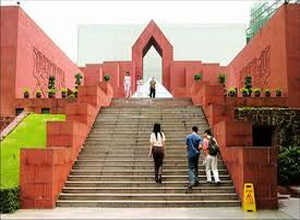
Nanyue King’s Tomb Musem (Chinese: 南越王墓博物馆) is located in Jiefangbei Road, Yuexiu District, Guangzhou. The owner of the tomb is the second king of Nanyue, Zhao Mo (r. 137 BC – 122 BC).It is well known for its well-preserved tomb and the most burial artifacts from the Han Dynasty in the Lingnan (south the Nanling Mountain) area.
Hidden 20 meters underground, covering 14,000 square meters, the tomn is made up of 750 huge stones with colorful murals, and houses over 1,000 pieces of cultural relics, gold and silver vessels, musical instruments and terra cotta wares in particular, featuring the Nanyue culture. There are even human sacrifices of 15 courtiers to be buried alive with the king. Alongside Chinese artifacts, pieces from the Iranian and Hellenistic Central Asian regions have been found; a Persian silver box found in the tomb is the earliest imported product found to date in China.
The Spotlight of the mausoleum is a silk-jade garment made up of 2,291 pieces of jade. The garment is unique for its jade pieces connected by silk which makes it the only one of its kind in the world.
Admission: CNY12
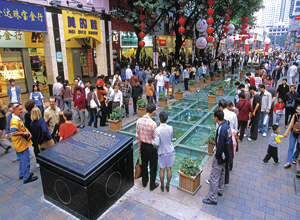
Beijing Road Pedestrian Street (Chinese: 北京路步行街) is a bustling commercial street in all ages of Guangzhou, located in the city center. In the middle of the road, there is a part of ancient road underground. It is now dug out and show for free all around the day. The site tells people that Beijing Road has existed here for nearly one thousand years.
Beijing Road Pedestrian Street is the busiest pedestrian street in Guangzhou. There are shopping malls, department stores, clothes shops, supermarkets, book stores, restaurants, sports goods shops, musical instrument stores and other shops. From this road, you can get lots of cheap goods that really are fit for westerners and you will be surprised to find that fashion clothes there are so cheap. Bargin is necessary.
Beijing Lu is reachable by the GongYuanQian station of Metro Line 1 or 2.
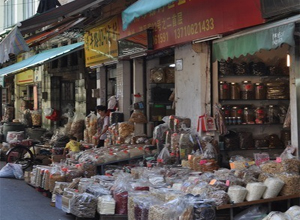
Qingping Market
Set up in 1979, Qingping Market (Chinese: 清平市场) is located at the bank of the Pearl River. With an area of 11200㎡, the market is specialized in agricultural and sideline products as well as Chinese heral medicines. The products include meat, eggs, vegetables, seafood, Chinese herbal medicines, dried fruits, flowers, birds and fishes, etc. The various products and the traditional features of the market attract lots of tourists and even government officals in and abroad to feel the “real China experience”. The market was authorized as the first Chinese herbal medicine market in China in 1996.
The market is accessible from Huangsha Station of Metro Line 1.
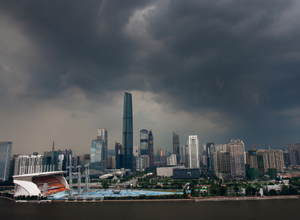
Zhujiang New Town (Chinese: 珠江新城) is the new CBD (central business district) of Guangzhou. It is located in the junction of the three districts-Tianhe, Yuexiu and Haizhu, between Huangpu Avenue in the north and the Pearl River in the south, and between Guangzhou Avenue as the west and the South China Expressway the east. It is one of the three national level CBDs, along with Beijing CBD and Shanghai Lujiazui Finance and Trade Zone.
It includes many business landmark buildings, namely Guangzhou Opera House, Guangzhou New Library, Huacheng Square, the new Guangdong Museum, the second Children’s Palace, Guangzhou International Finance Center, Happy Valley Shopping Mall, and the new Canton Tower.
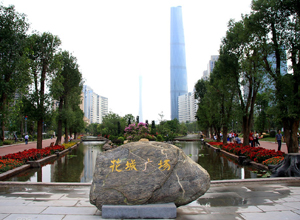
Huacheng Square
Huacheng Square (Chinese: 花城广场), or Flower City Square, is located in Zhujiang New Town’s CBD, Guangzhou. It is a renowned sightseeing and shopping destination of the city. Walking in the Huacheng square people can appreciate the green surroundings and a magnificent view of the Canton Tower across the Pearl River.
With the total area of about 560,000 square meters, Huacheng Square is 10 times larger than the Guangzhou People’s Park. Underneath the square is a large underground shopping mall, the “Mall of the World”, run by Hong Kong group Lan Kwai Fong. The three-leveled underground network also contains a large parking lot and grants access to Metro lines 3 and 5.
There are several famous sites surrounding the square, including the Guangdong New Museum, Guangzhou Opera House, Guangzhou International Financing Center, and Guangzhou No.2 Children’s Palace, etc.
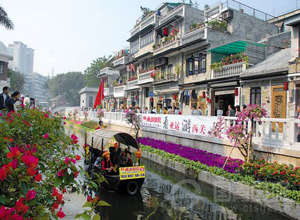
Located in the heart of the historic Xiguan districst and adjacent to the Pearl River, Lizhiwan Creek (Chinese: 荔枝湾) is home to the former sites of many famous people and gardens, as well as a well-known scenic spot in Guangzhou. it was listed as one of the eight scenic spots in Guangzhou in the Ming Dynasty (1368–1644).
Around the watercourse of Lizhiwan Creek, is the Xiguan Ancient Houses, where the cultural essence of Guangzhou lies, just like the Hutongs of Beijing and Li-Long of Shanghai. Xiguan Museum has also been built.
Important historic sites include Liang Ancestral Hall, Liwan Lake, Haishan Xian Guan Garden, Former Residence of Jiang Guangnai, Liwan Museum, Wen Pagoda, and Renwei Temple.
It is better to visit the Lizhiwan Creek on a rainy day. Strolling on the Longjing Bridge, you may lean against the rails in the drizzles to appreciate the boats swaying in the river, while your mind has already drifted away to earlier times. On sunny days brilliant flowers on both banks competing to bloom will make the stream filled with reflections of sunlight and colour.
A Lizhiwan creek cruise is a suggested activity. You may buy tickets in front of the Liang Ancestral Hall. Along your trip you may experience the local customs of Xiguan while listening to the singing of Cantonese music by Si Huo Ju (private institutions). Twenty-minute’s cruise will take you to the Liwan Lake, during which a staff will introduce the information about the creek.
Here you may also try some local Xiguan specialities like rice flour noodles, Kuih lapis, Tingzai porridge, Qingping chicken, and cured meat.
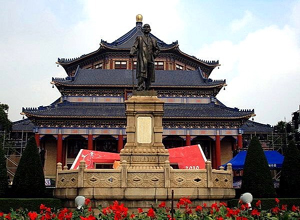
Sun Yat-sen Memorial Hall (Chinese: 孙中山纪念堂) in Guangzhou is a monument to Dr Sun Yat-sen, the forerunner of Chinese democratic revolution, who overthrew the feudal Chinese empire. It was constructed between 1929 and 1931 by the people of Guangzhou and overseas Chinese.
The hall is a large octagonal structure of typical Chinese architectural style. It houses a large stage that seats thousands of people with sound equipment and is an important place for conferences and performances. In the hall there is also a display gallery showing pictures and letters of Sun Yat-sen.
A bronze statue of Sun Yat-sen was erected in front of the main entrance. The oldest ceiba of Guangzhou grows here,as well as two biggest white jade orchid trees of the city. Situated on the southern slope of Yuexiu Hill, the hall ahs a nice environment.
Admission: CNY10
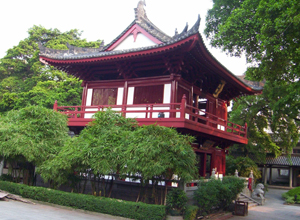
Six Banyan Tree Temple (Chinese:六榕寺) is an ancient Buddhist temple in Guangzhou, with a history of more than 1400 years. The temple got its current name from a great poet called Su Dongpo because of the six banyan trees he saw there. The vitality of the trees put him in a good mood and cheered him up. When the abbot of the monastery invited him to suggest a name, Su Dongpo wrote down its present name.
The temple is most attractive for the elegent Six Banyan Pagoda or Flower Pagoda inside. The pagoda is an octagonal building, reaching up seventeen storeys. It is where the Buddhist relics are placed.The pagoda not only has a nice appearance, but also provides visitors a good place to overlook enchanting scenery around. There are hundreds of small posing Buddha’s peering out at visitors as they make the climb up the steep stairs.
Burning joss sticks is a Buddhist etiquette not to miss when visiting there. Numerous people come to burn the joss stick in order to be blessed by gods.
Admission Fee: CNY 5 (Six Banyan Temple); CNY10 (Six Banyan Pagoda)








